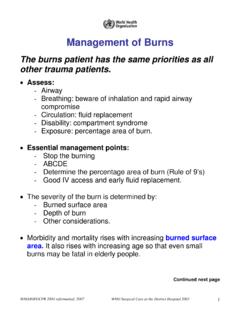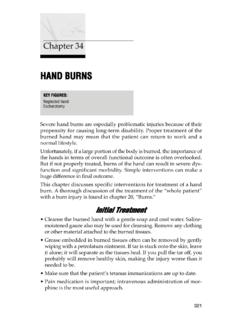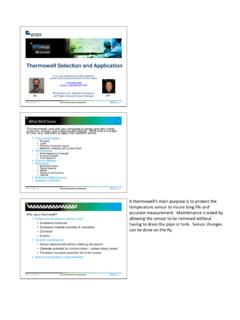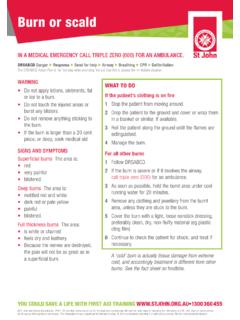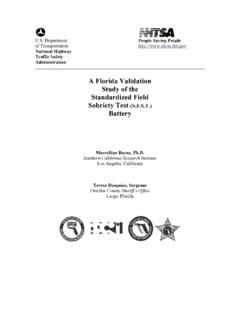Transcription of Burns
1 Burns Mass trauma and disasters such as explosions and fires can cause a variety of serious injuries, including Burns . These can include thermal Burns , which are caused by contact with flames, hot liquids, hot surfaces, and other sources of high heat as well as chemical Burns and electrical Burns . It is vital that people understand how to behave safely in mass trauma and fire situations, as well as comprehend basic principles of first aid for burn victims. For Burns , immediate care can be lifesaving. Note: Most victims of fires die from smoke or toxic gases, not from Burns (Hall 2001). This guideline covers burn injuries. Background Information On average in the United States in 2000, someone died in a fire every 2 hours, and someone was injured every 23 minutes (Karter 2001).
2 Each year in the United States, million burn injuries require medical attention (American burn Association, 2002). o Approximately 50,000 of these require hospitalization; 20,000 have major Burns involving at least 25 percent of their total body surface, and approximately 4,500 of these people die. Up to 10,000 people in the United States die every year of burn -related infections. Only 60 percent of Americans have an escape plan, and of those, only 25 percent have practiced it (NFPA, 1999). Smoke alarms cut your chances of dying in a fire in half (NFPA, 1999). Escape Information Safeguard Your Home Install smoke detectors on each floor of your home.
3 One must be outside the bedroom. Change batteries in smoke detectors at least once a year. (Never borrow smoke alarm batteries for other purposes). Keep emergency phone numbers and other pertinent information posted close to your telephone. Draw a floor plan and find two exits from each room. Windows can serve as emergency exits. Practice getting out of the house through the various exits. Designate a meeting place at a safe distance outside the home. Respond to every alarm as if it were a real fire. Call the fire department after escaping. Tell them your address and don't hang up until you're told to do so. Let them know if anyone is trapped inside.
4 Never go back into a burning building to look for missing people, pets, property, etc. Wait for firefighters. Hotel and Workplace Fire Safety: Become familiar with exits and posted evacuation plans each time you enter a building. Leam the location of all building exits. You may have to find your way out in the dark. Ensure that fire exits are unlocked and clear of debris. All buildings, whether homes, workplaces or hotels, should have working smoke alarm systems. Make sure you know what the alarm sounds like. Respond to every alarm as if it were a real fire. If you hear an alarm, leave immediately and close doors behind you as you go. Establish an outside meeting place where everyone can meet after they've escaped.
5 Call the fire department after escaping. Tell them your address and don't hang up until you're told to do so. Let them know if anyone is trapped inside. Never go back into a burning building to look for missing people, pets, property, etc. Wait for firefighters. If You Are Trapped in a Burning Building: Smoke rises, so crawl low to the ground, where the air will be cleanest. Get out quickly if it is safe to leave. Cover your nose and mouth with a cloth (moist if possible). Test doorknobs and spaces around doors with the back of your hand. If the door is warm, try another escape route. If it's cool, open it slowly. Slam it shut if smoke pours through.
6 Use the stairs, never use an elevator durjng a fire. Call the fire department for assistance if you are trapped. If you cannot get to a phone, yell for help out the window. Wave or hang a sheet or other large object to attract attention. Close as many doors as possible between yourself and the fire. Seal your door with rags. Open windows slightly at the top and bottom, but close them if smoke comes in. First Aid What you do to treat a burn in the first few minutes after it occurs can make a huge difference in the severity of the injury. Immediate Treatment for burn Victims 1. Stop, Drop, and Roll to smother flames. 2. Remove all burned clothing. If clothing adheres to the skin, cut or tear around burned area.
7 3. Remove all jewelry, belts, tight clothing, etc., from over the burned areas and from around the victim's neck. This is very important; burned areas swell immediately. Types of Burns First-Degree Burns : First-degree Burns involve the top layer of skin. Sunburn is a first- degree burn . Signs: Red Painful to touch Skin will show mild swelling Treatment: Apply cool, wet compresses, or immerse in cool, fresh water. Continue until pain subsides. Cover the burn with a sterile, non-adhesive bandage or clean cloth. Do not apply ointments or butter to burn ; these may cause infection. Over-the-counter pain medications may be used to help relieve pain and reduce inflammation.
8 First degree Burns usually heal without further treatment. However, if a first- degree burn covers a large area of the body, or the victim is an infant or elderly, seek emergency medical attention. Second-Degree Burns : Second-degree Burns involve the first two layers of skin. Signs: Deep reddening of the skin Pain Blisters Glossy appearance from leaking fluid Possible loss of some skin Treatment: Immerse in fresh, cool water, or apply cool compresses. Continue for 10 to 15. minutes. Dry with clean cloth and cover with sterile gauze. Do not break blisters. Do not apply ointments or butter to Burns ; these may cause infection Elevate burned arms or legs.
9 Take steps to prevent shock: lay the victim flat, elevate the feet about 12. inches, and cover the victim with a coat or blanket. Do not place the victim in the shock position if a head, neck, back, or leg injury is suspected, or if it makes the victim uncomfortable. Further medical treatment is required. Do not attempt to treat serious Burns unless you are a trained health professional. Third-Degree Burns : A third-degree burn penetrates the entire thickness of the skin and permanently destroys tissue. Signs: Loss of skin layers Often painless. (Pain may be caused by patches of first- and second-degree Burns which often surround third-degree Burns ).
10 Skin is dry and leathery Skin may appear charred or have patches that appear white, brown or black. Treatment: Cover burn lightly with sterile gauze or clean cloth. (Don't use material that can leave lint on the burn ). Do not apply ointments or butter to Burns ; these may cause infection Take steps to prevent shock: lay the victim flat, elevate the feet about 12 inches. Have person sit up if face is burned. Watch closely for possible breathing problems. Elevate burned area higher than the victim's head when possible. Keep person warm and comfortable, and watch for signs of shock. Do not place a pillow under the victim's head if the person is lying down and there is an airway burn .










